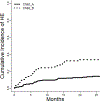Incidence and Bedside Predictors of the First Episode of Overt Hepatic Encephalopathy in Patients With Cirrhosis
- PMID: 32773463
- PMCID: PMC7853725
- DOI: 10.14309/ajg.0000000000000762
Incidence and Bedside Predictors of the First Episode of Overt Hepatic Encephalopathy in Patients With Cirrhosis
Abstract
Introduction: Hepatic encephalopathy (HE) is associated with marked increases in morbidity and mortality for patients with cirrhosis. We aimed to determine the risk of and predictors for HE in contemporary patients.
Methods: We prospectively enrolled 294 subjects with Child A-B (70% Child A) cirrhosis and portal hypertension without previous HE from July 2016 to August 2018. The primary outcome was the development of overt HE (grade >2). We assessed the predictive power of model for end-stage liver disease-sodium (MELD-Na) score, the Inhibitory Control Test, the Sickness Impact Profile score, and the Bilirubin-Albumin-Beta-Blocker-Statin score. We also derived a novel predictive model incorporating MELD-Na score, impact of cirrhosis on daily activity (Likert 1-9), frailty (chair-stands per 30 seconds), and health-related quality of life (Short-Form 8, 0-100).
Results: The cohort's median age was 60 years, 56% were men, and the median MELD-Na score was 9. During a follow-up of 548 ± 281 days, 62 (21%) had incident overt HE with 1-year probability of 14% ± 2%, 10% ± 2%, and 25% ± 5% for Child A and B. The best model for predicting the risk of overt HE included MELD-Na, Short-Form 8, impact on activity rating, and chair-stands within 30 seconds. This model-MELDNa-Actvity-Chairstands-Quality of Life Hepatic Encephalopathy Score-offered an area under the receiver operating curve (AUROC) for HE development at 12 months of 0.82 compared with 0.55, 0.61, 0.70, and 0.72 for the Inhibitory Control Test, Sickness Impact Profile, Bilirubin-Albumin-Beta-Blocker-Statin, and MELD-Na, respectively. The AUROC for HE-related hospitalization was 0.92.
Discussion: This study provides the incidence of HE in a well-characterized cohort of contemporary patients. Bedside measures such as activity, quality of life, and physical function accurately stratified the patient's risk for overt HE.
Conflict of interest statement
4. Conflicts of interest. Tapper serves on advisory boards for Bausch Health, Rebiotix, and Mallinckrodt, consulted for Axcella, Kaleido, and Novo Nordisk. No other author has relevant conflicts of interest.
Figures




Comment in
-
MASQ-HE: Unmasking the Predictors of Overt Hepatic Encephalopathy?Am J Gastroenterol. 2021 Apr;116(4):836-837. doi: 10.14309/ajg.0000000000001010. Am J Gastroenterol. 2021. PMID: 33982961 No abstract available.
-
Finding Common Ground With Our MASQs Off.Am J Gastroenterol. 2021 Apr;116(4):837. doi: 10.14309/ajg.0000000000001048. Am J Gastroenterol. 2021. PMID: 33982962 Free PMC article. No abstract available.
References
-
- Bajaj JS, Wade JB, Sanyal AJ. Spectrum of neurocognitive impairment in cirrhosis: implications for the assessment of hepatic encephalopathy. Hepatology 2009;50:2014–2021. - PubMed
-
- Tapper EB, Risech-Neyman Y, Sengupta N. Psychoactive medications increase the risk of falls and fall-related injuries in hospitalized patients with cirrhosis. Clinical Gastroenterology and Hepatology 2015;13:1670–1675. - PubMed
-
- Ezaz G, Murphy SL, Mellinger J, et al. Increased Morbidity and Mortality Associated with Falls among Patients with Cirrhosis. The American journal of medicine 2018. - PubMed
-
- Arguedas MR, DeLawrence TG, McGuire BM. Influence of hepatic encephalopathy on health-related quality of life in patients with cirrhosis. Digestive diseases and sciences 2003;48:1622–1626. - PubMed
Publication types
MeSH terms
Grants and funding
LinkOut - more resources
Full Text Sources
Medical

